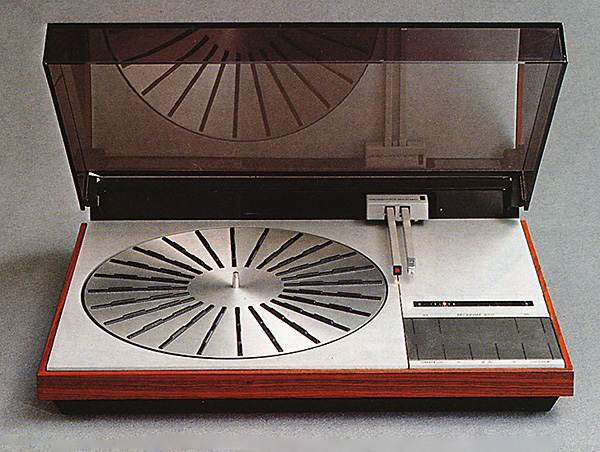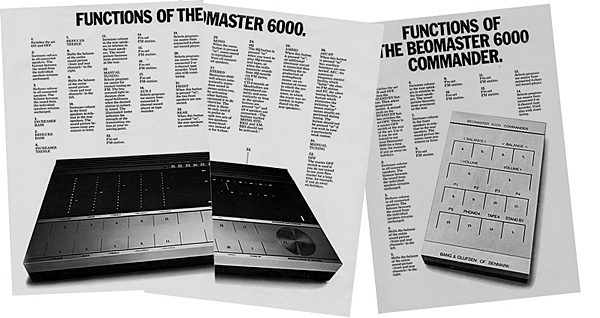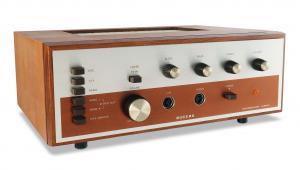B&O Beomaster 6000 4Ch

 With its four-channel amp and on-board SQ decoder, this '70s receiver was the lynchpin in what was arguably the most leading-edge quadraphonic system of its time...
With its four-channel amp and on-board SQ decoder, this '70s receiver was the lynchpin in what was arguably the most leading-edge quadraphonic system of its time...
The era of quadraphonic sound was not the hi-fi industry's finest. Appearing around 1973 but moribund by 1978, quadraphonic was the first big marketing failure by a sector that had so far enjoyed unalloyed success in convincing the public to buy into its latest developments. Confusing advertising, a damaging format war and a lack of consumer demand all played their part in the downfall of a concept which, at its peak, had been hailed as the future.
Format-wise, Sony/CBS led the way with the SQ system, while Sansui promoted its similar (but incompatible) QS method. Meanwhile, Victor (JVC) offered its CD4 technique, which saw four independent channels cut into a conventional-looking LP that was also stereo-compatible.
Gang Of Four
The big Japanese brands wasted no time in stacking up enormous four-channel receivers and complex decoders of every type to go with them, while in the USA quadraphonic 8-track tape cartridges made an appearance. In Europe, Philips and Grundig produced stylish quadraphonic music centres but it was Bang & Olufsen of Denmark who, in 1975, announced arguably the most advanced quadraphonic system of all. And at its heart was the Beomaster 6000 4Channel receiver here.

B&O's quadraphonic suite was expensive, costing 'a little over £1000' when introduced. The complete outfit included a specially adapted version of the firm's famous tangential tracking turntable [HFN June '14] and four Beovox P45 Uni-Phase 'panel' loudspeakers, which were designed to be mounted on a wall.
The system was designed to play both Sony/CBS SQ and Victor CD4 records, and also be compatible with a four-channel tape recorder. SQ was a 'matrix' system, meaning that rear channel information of limited separation was encoded as phase differences in the two channels of an otherwise conventional stereo recording. This was then decoded by an upgradeable module that was fitted inside the Beomaster 6000 4Channel receiver.
CD4 was different as it was a 'discrete' system that provided four completely independent channels. It worked by including a high-frequency carrier (45kHz) on the record and used a system similar to FM stereo radio to turn two channels into four. This created all manner of technical challenges, some of which were eased by mounting a special phono stage and the CD4 decoder in the matching Beogram 6000 turntable to eliminate HF losses in the connecting leads. The Beomaster 6000 4Channel's DIN turntable input therefore catered for four line-level signals without RIAA equalisation.

Problem Solved
The Beomaster 6000 4Channel could also receive FM stereo radio broadcasts. The tuner circuit was similar to that used in the Beomaster 3000 receiver, a model noted for its excellent FM performance. The tuner's output could be routed through the Beomaster's SQ decoder but when, after five years of deliberation, the BBC started quadraphonic broadcasts in 1978, it chose the incompatible 'Matrix H' system.
On paper the 6000 4Channel's power amplifier produced 4x40W, a substantial figure from such a slim piece of equipment. Despite the space constraints, AC coupling to the loudspeakers was used so four bulky capacitors had to be crammed in, along with a large mains transformer. For this last component, B&O chose a toroidal type and encountered the same problem of mechanical noise when the mains waveform was not exactly symmetrical as many other designers did. However, a simple circuit of capacitors and diodes cured the problem. This was patented and remained in use in B&O equipment into the 1990s.
Yet for all its intriguing technology, it was the Beomaster 6000 4Channel's striking appearance that won it the greatest praise. The work of designer Jacob Jensen, the receiver finally achieved the goal of having no projecting major controls, everything being sleek and flush. This was achieved by the use of electronic signal routing, meaning that all the unit's functions could be selected by short-travel push buttons that were cut into the stainless steel fascia.

A practical electronic means of volume and tone control had not yet been developed so the volume, balance (both left to right and front to back), treble and bass controls were all motorised. A single servo motor was used, with electromagnetic clutches to engage the relevant adjustment. A moving orange cursor showed the setting of each function. These refinements made it possible to add a comprehensive remote control, optional at first and standard thereafter (almost all of them had it in any case). Ultrasonic sound was used to convey the commands, the system used being the same as that employed in the later Beomaster 2400 [HFN Dec '19].
An important ergonomic innovation to appear on the Beomaster 6000 4Channel was the use of what B&O would later call 'electronic covers'. This saw certain functions only visible when relevant and in use. For example, the radio dial could only be seen if the FM free-tuning mode was selected (five pre-set programmes could also be called up). And the tuning meter was only on show if the AFC (Automatic Frequency Control) function was disabled.
It's A Hold Up
Setting up the Beomaster 6000 4Channel is not straightforward as all the connections are located in a small bay underneath it. Accessing them involves holding the heavy unit up at an odd angle and hoping that nothing falls out once it is laid back down again. A single socket caters for the turntable, although any four-channel source could be connected here as the inputs are at line level. Two tape connections are provided, one for front and one for rear. This is sensible as a stereo machine could be connected to either and used normally if desired.























































